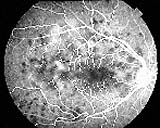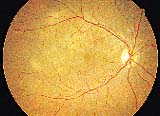Multidisciplinary meeting begins search for consensus on diagnosis, treatment of VKH
The disease mechanism of this relatively rare form of panuveitis is still poorly understood.
Click Here to Manage Email Alerts
LAKE ARROWHEAD, U.S.A. — Professionals in various disciplines from around the world gathered here for the Vogt-Koyanagi-Harada (VKH) Syndrome: First International Workshop. Even though the disease is easy to diagnose and treat effectively in about 80% of typical cases, the goal of the research workshop was to begin dialogue on a worldwide consensus for diagnostic criteria and treatment.
“VKH is usually severe panuveitis with an acute onset,” said Janet L. Davis, MD, an associate professor of ophthalmology at the Bascom Palmer Eye Institute in Miami. The disease “affects both eyes and can be seen in any age group.” Patients often present with exudative retinal detachments. “There is often a drastic and rapid reduction of vision in both eyes, down to the level of counting fingers,” Dr. Davis said.
Patients may have a premonition of the disease, with anterior segment inflammatory signs, headache, pain and light sensitivity. “But often within a week or two, the vision will decrease dramatically because of inflammation in the posterior segment,” she said.
Genetic predisposition
VKH syndrome, which is named after one German and two Japanese researchers who published independently early in the 20th century, has an “interesting genetic predisposition — a human leukocyte antigen [HLA] association,” Dr. Davis said. The HLA type that is associated with VKH is “very common in Asians, and similarly the disease of VKH is very common among Asians,” Dr. Davis said. In the United States, VKH is found “in people who are mainly darkly pigmented or who have Native American Indian ancestry. There is a genetic bridge between Asia and the Native American Indian related to the migration of peoples across the Bering Strait.” VKH also is seen in Hispanics and blacks.
 ---Fundus of right eye of patient with acute VKH
syndrome revealing exudative detachment of the retina involving the
fovea.
---Fundus of right eye of patient with acute VKH
syndrome revealing exudative detachment of the retina involving the
fovea.
Russell W. Read, MD, a fellow in uveitis and ophthalmic pathology at the Doheny Eye Institute in Los Angeles, served as program secretary for the workshop. “Over the past 2.5 years, we have seen over 700 cases of uveitis at Doheny,” Dr. Read said. Of that number, slightly over 5% were diagnosed as VKH. However, that percentage is greater than in most areas of the United States because of Southern California’s large Latino population. At least one U.S. study showed an incidence rate of VKH slightly lower than 1% in patients presenting with uveitis.
Dr. Read is hopeful that current diagnostic guidelines can be revised to account for both the acute onset and chronic stage of the disease. “It will probably be based on a breakdown of the different organ systems involved,” he said. “VKH doesn’t just affect the eye. It also affects the central nervous system [CNS], the inner ear and the cutaneous system.”
Nonetheless, Howard H. Tessler, MD, a professor of ophthalmology at the University of Illinois in Chicago, said that in most cases VKH is not a difficult disease to diagnose. “There is usually an appearance that is pretty characteristic in most patients,” he said. The disease “usually begins acutely with a severe headache and stiffness of the neck. Patients can have neurological symptoms, specifically meningitis-type symptoms.” Patients also frequently develop auditory symptoms early on, such as tinnitus and decreased hearing.
VKH often becomes bilateral, with patients experiencing blurred vision. “Sometimes there is pain and discomfort,” Dr. Tessler said. Patients also usually develop exudative retinal detachments. In fact, Dr. Tessler believes that exudative retinal detachment is probably the most prominent characteristic of the disease.
Current diagnostic criteria
The American Uveitis Society diagnostic criteria for VKH syndrome include no history of ocular trauma and at least one finding in three out of the following four categories: 1) bilateral chronic iridocyclitis; 2) posterior uveitis, including exudative retinal detachment, forme fruste of exudative de- tachment, disk hyperemia or edema and sunset glow fundus; 3) neurologic signs: tinnitus, meningismus, cranial nerve or CNS problems, or pleocytosis on central spinal fluid (CSF) exam; 4) cutaneous findings of alopecia, poliosis and/or vitiligo. “Most practitioners agree with this criteria,” Dr. Tessler said.
In addition, there are at least four distinct phases of VKH syndrome: 1) prodromal stage: neurologic symptoms only (headache, tinnitus, meningismus); 2) uveitis stage: exudative retinal detachment, vitritis, disk hyperemia; 3) chronic stage: retinal pigmentary changes, sunset glow fundus, Dalen-Fuchs nodules, Sugiura sign; 4) recurrent stage: predominantly anterior uveitis. “There also is a dermatologic stage that frequently occurs during the chronic stage,” Dr. Tessler said. “A minority of patients will develop hair loss and depigmentation of their skin and whitening of their hair. This frequently occurs months after the disease initially begins.”
Dr. Tessler said that it is important that VKH be accurately diagnosed early. “If not, the disease can become very severe and require a tremendous amount of medicine,” he said. Fluorescein angiography is one of the laboratory investigations that should be routinely conducted in clinically suspected cases of VKH syndrome. “The fluorescein angiogram has a characteristic picture of multiple subretinal leakage areas that tend to enlarge over time,” Dr. Tessler said.
Indocyanine green (ICG) choroidal angiography, ultrasonography and lumbar puncture for CSF analysis, among others tests, also have been proposed. One Japanese study (Eur J Ophthalmol. 1997;7(2):163-170) concluded that ICG choroidal angiography provides a wider variety of pictures than fluorescein angiography. “However, I’m not sure this type of angiography is that much more helpful,” Dr. Tessler said. “I believe fluorescein angiography is the standard right now.”
Two phases of treatment
Gary N. Holland, MD, chief of the cornea, external ocular disease and uveitis division at the Jules Stein Eye Institute in Los Angeles, was a workshop coordinator at the meeting here. VKH syndrome “can be treated very successfully if it is treated appropriately,” Dr. Holland said. “It really depends on the clinician having a good understanding of the course of the disease.”
Dr. Holland, who also is director of the Inflammatory Disease Center at the Jules Stein Eye Institute, said that treatment can be divided into two phases. “The first phase is the treatment of the initial severe posterior uveitis at the onset of the disease, which is characterized by an exudative retinal detachment,” he said. “This is usually managed very successfully with high-dose systemic corticosteroids.” Occasionally, patients will require a treatment other than oral corticosteroids because of their intolerance to steroids. “Immunosuppressive drugs are sometimes used. Cyclosporine is one alternative at onset,” Dr. Holland said. “Another alternative is cyclophosphamide.”
 ---Fluorescein angiogram of same patient showing
typical findings of multiple hyperfluorescent spots with pooling of fluorescein
in the subretinal space.
---Fluorescein angiogram of same patient showing
typical findings of multiple hyperfluorescent spots with pooling of fluorescein
in the subretinal space.
A number of patients, though, progress to a chronic phase, “in which they have an anterior uveitis that is less responsive to corticosteroids,” Dr. Holland said. “Many of those patients require immunosuppressive therapy to control the anterior component of the disease. For persistent anterior uveitis, azathioprine and methotrexate can be very effective treatments.”
In any event, Dr. Holland does not recommend observation without any drug therapy. “Without intervention, patients will definitely get worse,” he said. “I believe there is general agreement on the approach to treatment, if not the specific drugs. Very aggressive treatment at the onset is required. This is the best way to prevent complications and preserve vision.” Still, “one subject of discussion that requires further investigation is the duration of initial treatment. Some clinicians feel that continued treatment for as long as 6 months will improve the patient’s prognosis.”
Potential complications
Regarding potential adverse events with therapy, “clinicians always have to be concerned about the side effects of treatment, especially chronic oral corticosteroids,” Dr. Holland said. In addition, VKH syndrome “can be complicated by the development of posterior synechiae, cataracts, secondary glaucoma and subretinal neovascular membranes.”
In Japan, patients with VKH are often treated with early, high-dose intravenous steroids. “Patients are hospitalized from 3 to 7 days,” said Ronald E. Smith, MD, professor and chairman of the department of ophthalmology at the Doheny Eye Institute and the University of Southern California School of Medicine in Los Angeles. “But we find here in the United States that most patients do pretty well taking systemic [oral] steroids.” Added Dr. Read, “whether intravenous versus oral steroids makes a difference in long-term outcomes of the disease is unknown.”
A recent Japanese study (Br J Ophthalmol. 1999;83(1):39-42] concluded that a high incidence of glucose intolerance is found in the acute stage of VKH, but that glucose intolerance improves in most cases after systemic corticosteroid therapy. The study also suggested that this glucose intolerance may be related to the autoimmune inflammatory process of the disease.
Triggering mechanism still undefined
Dr. Smith said the medical community has yet to determine the precise mechanism that triggers VKH syndrome. “Some people believe it’s some type of autoimmune reaction to the pigment molecules in the eye,” he said. “There also is still a lingering suspicion that it might be a virus of some sort.” Once an accurate mechanism has been determined, “then a more directed and specific therapy can be developed. I believe that will probably occur. We’re still using a broad-based approach to treatment of this entity.”
Dr. Smith himself speculated that VKH syndrome “is some type of localized autoimmune reaction to some part of the retina or the choroid. This could be triggered by a virus. There also is some evidence that genetic susceptibility could be involved.” In essence, “I believe it will probably end up being a combination of an organism or a protein from an organism occurring in a genetically susceptible individual.”
In any event, “for uveitis in general, we need more directed therapies,” Dr. Read said. “We’re treating the eye with a pill that affects the entire body. This is less than an ideal situation. We would certainly much prefer to have targeted therapy — either regionally administered, such as a drop, or an injection around the eye or in the eye, or systemically administered that is regionally targeted to the eye.”
For Your Information:
- Janet L. Davis, MD, can be reached at Bascom Palmer Eye Institute, 900 N.W. 17th St., Miami, FL 33136 U.S.A.; +(1) 305-326-6377; fax: +(1) 305-326-6417. Dr. Davis has no direct financial interest in any of the products mentioned in this article, nor is she a paid consultant for any companies mentioned.
- Russell W. Read, MD, can be reached at Doheny Eye Institute, 1450 San Pablo St., DVRC 211, Los Angeles, CA 90033 U.S.A.; +(1) 323-442-6646; fax: +(1) 323-442-6634. Dr. Read has no direct financial interest in any of the products mentioned in this article, nor is he a paid consultant for any companies mentioned.
- Howard H. Tessler, MD, can be reached at the University of Illinois, Lions Eye Research Bldg., 1905 W. Taylor, Chicago, IL 60612 U.S.A.; +(1) 847-662-4016; fax: +(1) 847-662-6982. Dr. Tessler has no direct financial interest in any of the products mentioned in this article, nor is he a paid consultant for any companies mentioned.
- Gary N. Holland, MD, can be reached at Jules Stein Eye Institute, 100 Stein Plaza, UCLA, Los Angeles, CA 90095 U.S.A.; +(1) 310-825-9508; fax: +(1) 310-794-7906. Dr. Holland has no direct financial interest in any of the products mentioned in this article, nor is he a consultant for any companies mentioned.
- Ronald E. Smith, MD, can be reached at Doheny Eye Institute, 1450 San Pablo St., DEI 5th Floor, Los Angeles, CA 90033 U.S.A.; +(1) 323-342-6424; fax: +(1) 323-442-6402. Dr. Smith has no direct financial interest in any of the products mentioned in this article, nor is he a paid consultant for any companies mentioned.
